An interview with Alan Rabinowitz, author of the new book, An Indomitable Beast: the Journey of the Jaguar

Female jaguar (staring into camera) with subadult male offspring moving through an old oil palm plantation in the jaguar corridor of Colombia. Photo by: Esteban Payan, Panthera.
For thousands of years the jaguar was a God, then it was vermin to be destroyed, and today it is the inspiration for arguably the most ambitious conservation effort on the planet. A new book by renowned big cat conservationist, Alan Rabinowitz, tells this remarkable story from the jaguar’s evolutionary origins in Asia to its re-emergence today as a cultural and ecological symbol. In An Indomitable Beast: the Journey of the Jaguar, Alan Rabinowitz explores how modern day science, including DNA research, has upended past convictions about the jaguar and proven that this cat may be the ultimate survivor. And, as such, has much to teach us.
Of the five great cats in the genus Panthera —lions, tigers, jaguars, leopards, snow leopards —the jaguar is the only one found in the Americas. It is also, arguably, the least threatened. Combining fascinating personal adventures and cutting-edge science, Rabinowitz’s new book works to uncover what makes the jaguar such a survivor, even in the midst of vast ecological destruction. Like any good detective story, the conclusions he draws are both illuminating and revelatory, painting a new picture of one of the world’s most worshipped, beloved, and reviled mega-predators.
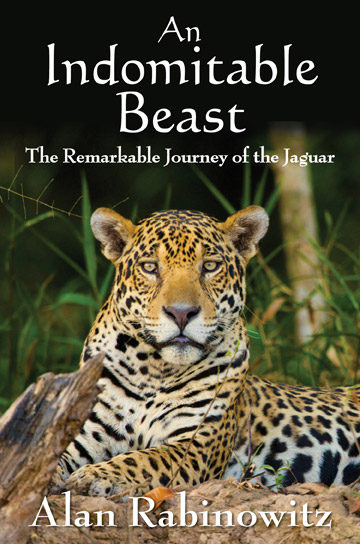 |
And the story has implications for any struggling conservationist in the on-going development of the Jaguar Corridor Initiative. A vast ambition, spearheaded by Rabinowitz, that would protect and restore jaguar habitat (home to countless other species) from Argentina to Mexico, covering 18 countries. Given its breadth and scale, the project is arguably the biggest conservation effort today. And it isn’t just a pipe-dream: Rabinowitz’ organization, Panthera, has signed conservation agreements with six jaguar-range nations to date, including Belize earlier this year.
Rabinowitz is one of the world’s most famous big cat conservation scientists, having cut his teeth on jaguar research in Belize in the 1980s. Outside of conservation circles, Rabinowitz is also known as one of the only guests to make Stephen Colbert cry on camera. Today, Rabinowitz is the CEO of the NGO, Panthera, which is the world’s leading conservation group devoted to cats.
In a 2014 interview with mongabay.com, Alan Rabinowitz talks about the Jaguar Corridor, rising threats to big cat, and whether this top predator will ever re-colonize the south-western U.S.
AN INTERVIEW WITH ALAN RABINOWITZ

Jaguar emerging from the wetlands of the Pantanal in Brazil. Photo by: Rhett A. Butler.
Mongabay: Will you tell us about the Jaguar Corridor?
Alan Rabinowitz: The Jaguar Corridor is like a highway —a pathway of movement for dispersing jaguars that are leaving their home areas to find new places and new jaguar populations with which to settle. Just as highways crisscross the United States, the Jaguar Corridor covers the species’ entire current range from northern Mexico to northern Argentina. And like highways, the corridor is not a single path, but consists of multiple travel routes, through many different kinds of human landscapes containing mosaics of forests, cattle ranches, citrus and oil palm plantations, vegetable gardens, anything that allows a jaguar to sneak by, unseen and unimpeded. The beauty of the Jaguar Corridor is that it is not a conceptual model dreamed up by humans. Variations of the jaguar corridor have always been in place, from the Pleistocene onward, only to be recently uncovered and understood through the use of modern genetic tools and technological advances in wildlife research that show us where jaguars are moving and how. The existence of the Jaguar Corridor, which we now seek to delineate and maintain, prevents fragmentation of populations and allows genetic connectivity so that the jaguar remains one species—with no subspecies. This makes the jaguar the world’s only large, wide-ranging carnivore that is still fully connected genetically throughout its current distribution.
Mongabay: Jaguars are some of the least threatened big cats on the planet. So why should we spend conservation attention on them?
 Alan Rabinowitz. Photo by: Steve Winter, Panthera. |
Alan Rabinowitz: This is an excellent question and one I battle with all the time. One of the failings of wildlife conservation is that we continually engage in crisis management, focusing on and waiting for the next species that appears to be on the cliff’s edge. Only then do we sound the battle cry and pour large sums of money and efforts into trying to save a species that is critically endangered. Any successful business manager or corporate CEO knows that the best results of any endeavor comes from looking ahead, anticipating problems and addressing them before they arise. The fact that jaguars have been more resilient and, in many ways, more lucky in their survival than other big cats is EXACTLY why we should focus our attention and conservation efforts on them. This could be the world’s greatest success story for large carnivore conservation and show how big predators such as these can indeed live with humans. The reasons behind the success of the jaguar, which I explore in my book An Indomitable Beast, is something that should be more intensely studied and emulated. The jaguar can teach us valuable lessons about how we can save other more threatened species and how humans, themselves, can better survive a very uncertain, turbulent future.
Mongabay: How did genetic research revolutionize our understanding and the conservation of jaguars?
Alan Rabinowitz: It was cutting edge genetic research tools, used to examine jaguar fecal samples from different countries, that provided definitive evidence for the genetic continuity of the jaguar throughout its range. What was uncovered through genetic research was unknown to us previously. The prevalent belief of the time was that most large jaguar populations had already fragmented and been cut off from other jaguar populations, resulting in restricted breeding behavior that led to perhaps 8 different jaguar subspecies. The new genetic data however indicated that at least some jaguars were finding their way through the human landscape, areas thought to be unpassable, from population to population, from Mexico to Argentina, to preserve the genetic integrity of the species. Unlike what we were seeing with every other wide-ranging large carnivore species in the world, no major jaguar population appeared to be completely cut off from others as we thought. In fact, the genetic data indicated that there was enough interbreeding throughout the species’ range that there appeared to be no jaguar subspecies. Further genetic research using more samples from more countries verified these results. There was only one jaguar species, no subspecies, still connected genetically throughout its range.
Mongabay: How hopeful are you for jaguars at the northern and southern edge of their range, i.e. Mexico and Argentina?
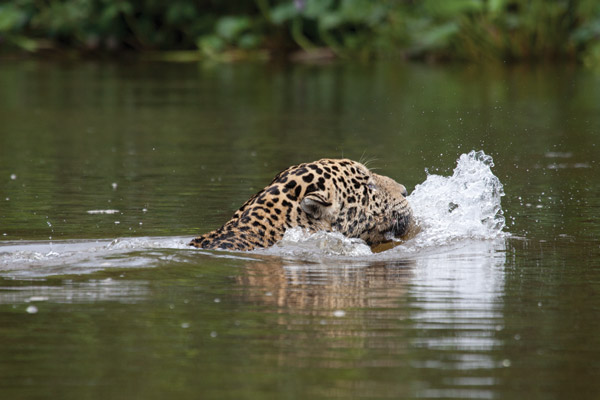
Jaguar swimming across a river as it moves through its range to hunt caiman and capybara along the riverbank. Photo by Steve Winter, Panthera.
Alan Rabinowitz: The jaguar populations at the most northern and southern extremities of their range are some of the most endangered populations, and are in the greatest danger of being cut off from other populations and perhaps even being wiped out. The edges of a species range are, by definition, areas of some of the greatest vulnerability to a species. I think that if we see further contraction of the jaguar’s range in the future, it will occur first at the northern and southern tips.
Mongabay: Do you think that jaguar has any chance of re-establishing itself in the southern U.S.?
Alan Rabinowitz: I think that the chances of the jaguar re-establishing itself in the southern U.S. without any intervention are slim to none. The northernmost jaguar population in Mexico which is the likely source of jaguars periodically crossing the United States border is, itself, under threat. I believe that any effort to aid the jaguar in this region should be directed at existing populations in northern Mexico.
Mongabay: Are you concerned about the potential for the proposed Gran Canal in Nicaragua to sever the Jaguar Corridor? How do jaguars get around the Panama Canal?
Alan Rabinowitz: Yes, we are concerned about both the proposed canal in Nicaragua, as well as expansion efforts on the existing Panama Canal. However we currently have agreements with both the governments of Panama and Nicaragua to work on conserving the jaguar and maintaining the integrity of the Jaguar Corridor in these countries. We are trying to be pro-active in our efforts with the government to ensure that whatever new development takes place, it still allows for areas where jaguars can easily navigate the landscape, by water or land.
Mongabay: Jaguars were once viewed as sacred animals, even deities, across their range. Is there anything left of this reverence for jaguars?
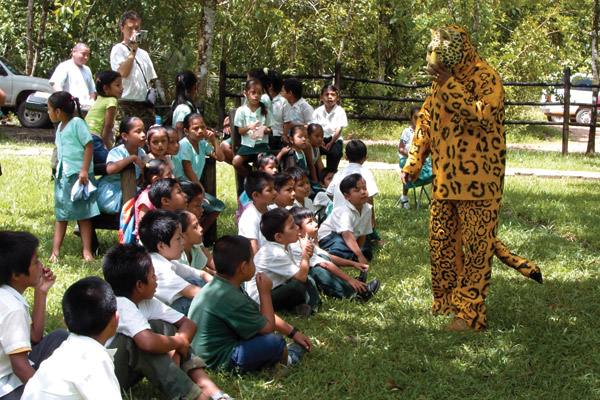
Local Maya schoolchildren being brought to the Cockscomb Jaguar Preserve in Belize to be taught about jaguars and other wildlife. Photo by: Becci Foster, Panthera.
Alan Rabinowitz: A reverence and respect for jaguars still exists among the people who live with them, though in a different way from the past. While many rituals and animistic beliefs of the past among indigenous and local communities have been replaced by Christian dogma, that place a clear separation between man and nature, the people of the jaguar still have real memories or recent experiences with an animal that, while no longer seen as supernatural, is viewed as something that enriches their life. While the ancient folklore and the cultural antecedents of the jaguar’s world has changed forever, what I call in my book the Jaguar Cultural Corridor, is not gone. It is different. People still feel a need to understand the natural world in which they live and depend upon. Where the jaguar sill walks, respect and awe for the power, potential savagery and the mystery of the living animal remains. What became clear to me after speaking to a multitude of indigenous people wherever I traveled was that the presence of jaguars, whether through economic benefits or spiritual and religious uplifting, helped invigorate and strengthen whatever community it was a part of. Where the jaguar roamed people felt they were part of something larger and stronger than themselves. Where jaguars were gone or in decline, people felt the loss. The Jaguar Cultural Corridor, having adapted to new people, new beliefs and the practicalities of the modern world is still alive.
Mongabay: The Jaguar Corridor has been seen by some as a new example of how conservation could move forward. How do we replicate the initiative in other parts of the world?
Alan Rabinowitz: The Jaguar Corridor represents the way actions should be scaled in order to guarantee success and sustainability for the conservation of large, wide-ranging species or entire wildlife communities. Conservation programs should take into account the entire range of a species, or the entire matrix of habitats and systems that allow for movement, dispersal, and genetic continuity between wildlife communities. Conservation activities must also realize that people and their actions are integral parts of the systems in which we work and should not always be viewed as problems to be fixed but rather as possible solutions to be used or manipulated. The Jaguar Corridor is more than just a new model of species conservation but also a modus operandi for working cooperatively and proactively with governments, private landowners, and developers. This initiative demonstrates how people and predators, development and conservation can, for the most part, coexist.
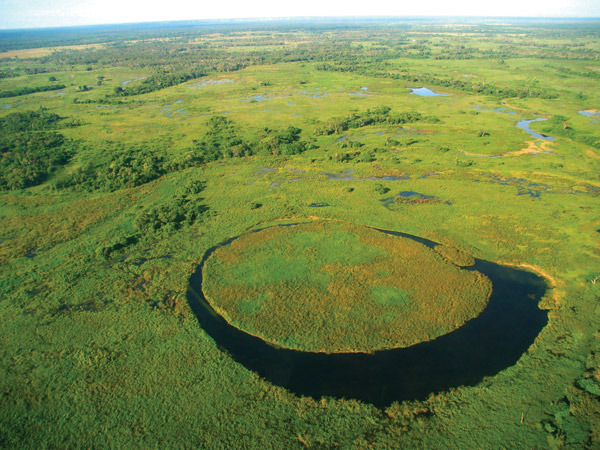
Expansive landscape mosaic of the northern Pantanal of Brazil. Photo by Steve Winter, Panthera.
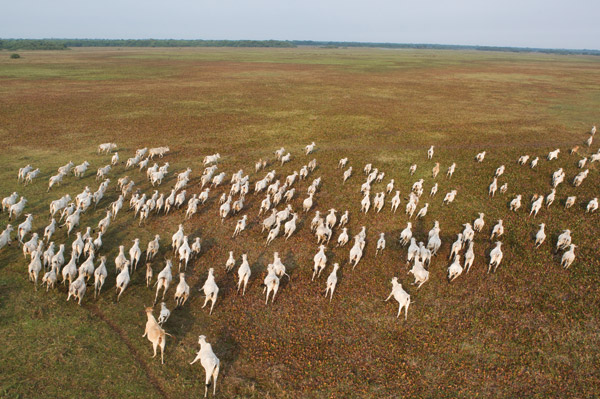
Free-ranging cattle during the dry season on the vast open landscape of the Pantanal. Such open areas have traditionally been maintained by fire and cattle grazing. Photo by Steve Winter, Panthera.
Related articles
The Gran Canal: will Nicaragua’s big bet create prosperity or environmental ruin?
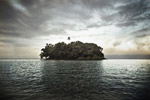
(08/27/2014) A hundred years ago, the Panama Canal reshaped global geography. Now a new project, spearheaded by a media-shy Chinese millionaire, wants to build a 278-kilometer canal through Nicaragua. While the government argues the mega-project will change the country’s dire economic outlook overnight, critics contend it will cause undue environmental damage, upend numerous communities, and do little to help local people.
Seeking justice for Corazón: jaguar killings test the conservation movement in Mexico
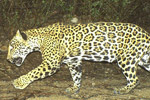
(07/31/2014) Eight years ago, a female jaguar cub was caught on film by a motion-triggered camera trap set in the foothills of canyons, oak forest, and scrubland that make-up the Northern Jaguar Reserve, just 125 miles south of the U.S.-Mexico border. Three years later, in 2009, the jaguar reappeared on film as an adult. They called her ‘Corazón’ for the distinctive heart-shaped spot on her left shoulder.
Four donors pledge $80 million for big cats
(06/03/2014) Four donors from around the world have pledged $80 million to cat conservation group, Panthera. The money will fund projects working to preserve tigers, lions, jaguars, cheetahs, leopards, snow leopards, and cougars over ten years.
Jaguars in Argentine Chaco on verge of local extinction

(12/23/2013) The majestic jaguar (Panthera onca), the largest of the New World cats, is found as far north as the southern states of the US, and as far south as northern Argentina. In the past jaguars ranged 1,500 kilometers (930 miles) further south, but their range has shrunk as habitat loss and human disturbance have increased. Overall, jaguars are classified as Near Threatened by the IUCN, but the level of risk facing jaguars varies by region. Populations in Argentina, at the present-day southern range limit, have previously been identified as some of the most threatened of them all.
60 big cats killed in Brazilian parks in last two years

(06/24/2013) At least 60 big cats have been killed within national protected areas in Brazil during the past two years according to a recent survey published in mongabay.com’s open access journal Tropical Conservation Science. The report, which focuses on jaguar (Panthera onca) and puma (Puma concolor) populations, within Brazilian protected areas shows that reserve management and use restrictions impact the level of big cat hunting.
Crazy cat numbers: unusually high jaguar densities discovered in the Amazon rainforest
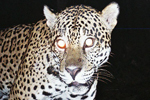
(05/16/2013) Jaguars (Panthera onca) are the biggest cat in the Americas and the only member of the Panthera genus in the New World; an animal most people recognize, the jaguar is also the third largest cat in the world with an intoxicatingly dangerous beauty. The feline ranges from the harsh deserts of southern Arizona to the lush rainforests of Central America, and from the Pantanal wetlands all the way down to northern Argentina. These mega-predators stalk prey quietly through the grasses of Venezuelan savannas, prowl the Atlantic forests of eastern Brazil, hunt along the river of the Amazon, and even venture into lower parts of the Andes.
Jaguars, tapirs, oh my!: Amazon explorer films shocking wildlife bonanza in threatened forest

(02/19/2013) Watching a new video by Amazon explorer, Paul Rosolie, one feels transported into a hidden world of stalking jaguars, heavyweight tapirs, and daylight-wandering giant armadillos. This is the Amazon as one imagines it as a child: still full of wild things. In just four weeks at a single colpa (or clay lick where mammals and birds gather) on the lower Las Piedras River, Rosolie and his team captured 30 Amazonian species on video, including seven imperiled species. However, the very spot Rosolie and his team filmed is under threat: the lower Las Piedras River is being infiltrated by loggers, miners, and farmers following the construction of the Trans-Amazon highway.
Can ranchers co-exist with jaguars?

(01/17/2013) Jaguar once roamed from the United States to Argentina, but today they’ve been eliminated from several range countries, including the United States. The chief reasons are habitat loss and direct killing by humans, putting ranchers and farmers at the heart of the issue. Both ranchers and farmers convert key jaguar habitat and kill the big cats as a threat to their livestock. However in parts of Brazil’s Pantanal, some ranchers are going about their business without killing jaguars. My Pantanal, a film by Andrea Heydlauff, Vice President of the wild cat conservation group Panthera, takes a look at one particular ranch that is helping prove that jaguars and ranchers can co-exist.
Jaguar conservation gets a boost in North and Central America

(09/27/2012) Jaguar conservation has received a huge boost in the past few months both in Latin America and in the U.S. An historic agreement singed between the world’s leading wild cat conservation organization Panthera and the government of Costa Rica in addition to a new U.S. Fish and Wildlife Service (FWS) proposal bring renewed hope to the efforts to revive the iconic jaguar in its current habitat and return the cats to the American Southwest.
Key mammals dying off in rainforest fragments

(08/15/2012) When the Portuguese first arrived on the shores of what is now Brazil, a massive forest waited for them. Not the Amazon, but the Atlantic Forest, stretching for over 1.2 million kilometers. Here jaguars, the continent’s apex predator, stalked peccaries, while tapirs waded in rivers and giant anteaters unearthed termites mounds. Here, also, the Tupi people numbered around a million people. Now, almost all of this gone: 93 percent of the Atlantic Forest has been converted to agriculture, pasture, and cities, the bulk of it lost since the 1940s. The Tupi people are largely vanished due to slavery and disease, and, according to a new study in the open access journal PLoS ONE, so are many of the forest’s megafauna, from jaguars to giant anteaters.
Jaguars photographed in palm oil plantation
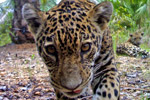
(06/06/2012) As the highly-lucrative palm oil plantation moves from Southeast Asia to Africa and Latin America, it brings with it concerns of deforestation and wildlife loss. But an ongoing study in Colombia is finding that small palm oil plantations may not significantly hurt at least one species: the jaguar. Researchers in Magdalena River Valley have taken the first ever photos of jaguars in a palm plantation, including a mother with two cubs, showing that the America’s biggest cat may not avoid palm oil plantations like its Asian relative, the tiger.